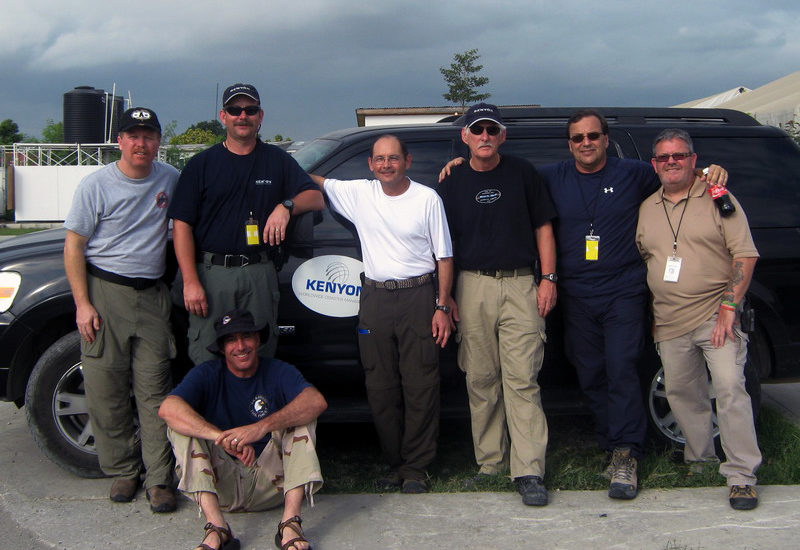Part 12: Crisis Leadership


Kenyon Leadership (pictured center, President Jerry Novosad, pictured far right, VP of Operations, Robert Rowntree) pictured with Kenyon Team Members – structural, safety, and medical experts – during operations in Haiti following the earthquake in 2010.
This is part 12 of a 12-part series describing the consequences of a typical large-scale loss of life incident. Following the framework of the 12 Principles of Crisis Management, I describe these consequences and offer best practice solutions for each consequence.
Consequence 12
Large-scale loss of life events are a direct challenge to our ability to prevent accidents or control our environment. They are sudden and despite the fact that we know they will occur, they are unexpected. Successfully addressing the consequences of such events requires leadership; leadership of teams, of functional areas and leadership of the impacted business. For businesses, there is a potential vacuum in leadership if the CEO and others do not immediately move from management roles to leadership roles.
Solution
There are several key pieces to this solution. First, the CEO has to accept that such an event could occur – that the company could suffer a mass fatality event on the CEO’s watch. Secondly, the leadership has to participate in and lead the charge for being prepared. This means allocating funds and supporting and participating in drills and exercises, no matter how busy they are. Third, they build a team who can work well together and is comfortable making decisions and taking actions with little guidance. Fourth, they understand the difference between public relations and crisis communications – they’re prepared for transparent and open communications.
Those things are actually easy to achieve if the motivation is there. Sadly, not everyone who should achieve these do. I see a lot of companies fail simply because the CEO felt it would never happen to them and if it did, it is someone else’s job to take care of it. Finally, there are the personal traits or characteristics of a crisis leader. The four key traits I have seen to be the most important are:
(1) Self confidence – the confidence to make timely decisions, and to take responsibility for not only what has occurred but for what is occurring. This includes making changes when needed and not hesitating to take action. There will be lots of advisors, people with competing agendas, employees, customers, families and governments all wanting attention and all asking questions and needing direction. Spare time will not exist. You will look at your watch at noon, and in what seems likes five minutes you will check your watch again, and it will be midnight. So you need the confidence to quickly hear opinions, and then make and execute decisions.
(2) Calmness – the ability to project calmness and control, not control over the situation, but control over your own emotions and the response. People will be scared, afraid of what is next. Raised voices, even shouting and panic response are not uncommon. Leadership by title does not work here. Leadership by example does. Emotion begets emotion; a calm leader, by showing a measured but determined manner, is reassuring to those that are uncertain. People look to the leader to ascertain just how bad the situation is. When they see the leader calm, and in control, it lets them know that things will be okay.
(3) Focus – to quickly separate what is and is not important. Loss of life events are about knowing the forest and each tree in the forest, it is the detail and the big picture. However, they follow a logical pattern, so should the response. In the beginning, there may be quicker ways to do things, but often that results in a much longer process and not meeting the needs of the family. For example, it is very easy to tell people only what you think they want to hear, to protect them. That does not work, because people will find out and then they will no longer believe or trust you.
(4) Selflessness, true selflessness – it really does not matter how tired you get, or how many times you have to answer a survivor or family member’s questions or the holidays you will miss. It is not about you. When the response is over, and it will end, you will go home. You will not be the same person as you were before the incident occurred, but you will still go home. For survivors and the families, life is never the same and will not be an easy time. It, in fact, will be a very difficult time and often how well you do your job as a leader will determine how hard the time is for them.
There are programs and ways for leaders to develop these skills. They only require the self-awareness to know when you have them and don’t and what you need to work on. That is the difference between managers – people who do a great job within parameters and borders, and leaders – who solve the events that are, by many, considered unmanageable.
Examples
Think of the CEOs who where replaced during or immediately after a crisis, even those without loss of life.
“JetBlue Founder: Storm cost CEO job. Neelemen admits to being upset with being forced out of CEO spot following service problems that followed February ice storm” – CNN Money
“The Deepwater Horizon accident showed that there was still something deeply wrong with BP, and Hayward’s tone deaf performance during the early days of the oil spill only made things worse. By mid-June Hayward had stepped back from the oil spill, ceding day-to-day control of the response to the American BP executive Bob Dudley. Now it seems Hayward is gone for good. According to a senior U.S. official speaking to the Associated Press early Sunday afternoon, Hayward will be replaced as BP’s CEO, possibly as early as Monday when the company’s board meets in London.” – Time Magazine
Fortunately there are also very good examples, one being the tampering of pain reliever Tylenol in 1982, which resulted in six deaths and nearly toppled one of Americas most trusted brands.
As reported by US News:
“Rather than succumbing to panic, Johnson & Johnson CEO James Burke swiftly ordered a recall of 31 million bottles, which cost the company a staggering $50 million. In the weeks that followed, Burke and his management team went on the offensive. Within 10 weeks, the manufacturer introduced tamperproof packaging that revolutionized the industry. Johnson & Johnson also threw open the doors to the media to give the public an assurance of full transparency.
Within a year, Tylenol had regained more than 80 percent of its market share. Much of the credit goes to Burke and his management team, which decided to stick by the company’s core values of putting the customer first—even if it cost Johnson & Johnson dearly. “Values-driven companies do better in times of crisis,” says Dave Anderson, a leadership guru who has published several books on the subject.”

Joe Anderson
I enjoyed reading the article on 12 steps of Crisis Management. I especially felt enriched when you spoke to being truthful during times of great and unexpected stress and disaster.
I am a public information officer, PIO, for the forest service and am dispatched to disasters, especially wild land forest fires. It is during these crisis times those involved need to hear the truth, even though it might be hard to understand. The truth is always the best. That truth must be communicated in a calm and logical manner.
Thank you for affirming my style.
Joe Anderson